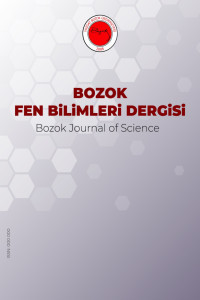Karyotype Analysis of Dianthus muglensis (Caryophyllaceae, Sileneae)
Karyotype Analysis of Dianthus muglensis (Caryophyllaceae, Sileneae)
The majority of the family Caryophyllaceae has about 2100 species classified in 80 genera, which are distributed in the northern hemisphere. The genus Dianthus, which has more than 300 species, is the second-largest genus of the family Caryophyllaceae. The karyological parameters such as chromosome numbers (basic and diploid), chromosome size, and karyotype asymmetry are important characters in plant cytotaxonomy. In many species of the genus Dianthus, the basic and diploid numbers are x = 15 and 2n = 30, respectively. The study aims to determine the chromosome number of Dianthus muglensis and to reveal the karyotype, ideogram, karyotype asymmetry and other detailed measurements. The chromosome number and karyotype formula are 2n = 30 and 20m + 10sm, respectively. The chromosome number of Dianthus muglensis was recorded here for the first time. The chromosome lengths range between 1.02 and 2.65 µm. Chromosome arm ratio, relative length and centromeric index are ranging from 1.03 to 2.29, 6.22 to 10.56, and 30.39 to 49.37, respectively. According to intrachromosomal and interchromosomal asymmetry values, Dianthus muglensis has a symmetrical karyotype. Since symmetrical karyotypes are generally seen in the early stages of karyotype evolution, Dianthus muglensis can be considered to be involved in the early stages of karyotype evolution. In addition, listed data have made important contributions to the cytotaxonomy of genus Dianthus: (i) basic number of x = 15, (ii) diploid number of 2n = 30, (iii) new karyotype formula of 20m + 10sm (iv) ploidy level of 2x, and (v) symmetrical karyotype.
Keywords:
Dianthus, Fimbriati, Chromosome, Cytotaxonomy,
___
- H. Reeve, “Dianthus L.,” in Flora of Turkey and the East Aegean Islands, vol. 2., Edinburgh University Press, 1967, pp. 99–131.
- E. Şahin, H. E. Eroğlu, E. Hamzaoğlu, and M. Koç, “Karyotype Analysis of Four Species of Dianthus Section Fimbriati (Caryophyllaceae, Sileneae),” Caryologia, vol. 69, no. 3, pp. 267–272, Jun. 2016, doi:10.1080/00087114.2016.1179527.
- D. Altay, H. E. Eroğlu, E. Hamzaoğlu, and M. Koç, “Karyotype Analysis of Some Taxa of Dianthus Section Verruculosi (Caryophyllaceae, Sileneae),” Turk. J. Bot., vol. 41, no. 4, pp. 367–374, Jul. 2017, doi:10.3906/bot-1612-30.
- E. Hamzaoğlu, M. Koç, and İ. Büyük, “Dianthus yilmazii (Caryophyllaceae), A New Species from Central Turkey,” Kew. Bull., vol. 76, pp. 523–530, Aug. 2021, doi:10.1007/S12225-021-09954-3.
- E. Martin, H. E. Eroğlu, E. Hamzaoğlu, M. Koç, A. Kelkitoğlu, E. Öztürk, E. Tanhaş, M. Maşa, H. Bozkurt, and F. N. Yavaş, “New Chromosomal Data of the Genus Dianthus Section Dentati (Caryophyllaceae, Sileneae),” Ant. J. Bot., vol. 6, no. 1, pp. 34–38, May 2022, doi:10.30616/ajb.1062628.
- H. E. Eroğlu, E. Martin, E. Hamzaoğlu, M. Koç, F. N. Yavaş, H. Bozkurt, and E. Tanhaş, “New Chromosomal Data of Dianthus Section Leiopetali (Caryophyllaceae, Sileneae),” Iğdır Univ. J. Inst. Sci. & Tech., vol. 12, no. 2, pp. 571–577 Jun. 2022, doi: 10.21597/jist.1068513.
- S. Khatoon and S. I. Ali, Chromosome Atlas of the Angiosperms of Pakistan. Department of Botany, University of Karachi, 1993.
- R. I. Gadnidze, T. N. Gviniashvili, I. M. Danelia, and M. V. Churadze, “Chromosome Numbers of the Species of the Georgian Flora,” Bot. Žh. (Moscow & Leningrad), vol. 83, no. 10, pp. 143–147, 1998.
- S. M. Ghaffari, “New or Rare Chromosome Counts of Some Angiosperm Species from Iran,” Iran J. Bot., vol. 11, no. 2, pp. 185–192, Jan. 2006.
- A. Jafari and M. Behroozian, “A Cytotaxonomic Study on Dianthus L. Species in North Eastern Iran,” Asian J. Plant Sci., vol. 9, no. 1, pp. 58–62, 2010, doi:10.3923/ajps.2010.58.62.
- A. K. Levan, K. Fredga, and A. A. Sandberg, “Nomenclature for Centromeric Position on Chromosomes,” Hereditas, vol. 52, no. 2, pp. 201–220, Dec. 1964, doi:10.1111/j.1601-5223.1964.tb01953.x.
- B. Paszko, “Critical Review and a New Proposal of Karyotype Asymmetry Indices,’’ Plant Syst. Evol., vol. 258, pp. 39–48, Mar. 2006, doi:10.1007/s00606-005-0389-2.
- L. Peruzzi and H. E Eroğlu, “Karyotype Asymmetry: Again, How to Measure and What to Measure?,” Comp. Cytogenet., vol 7, no. 1, pp. 1–9, Mar. 2013, doi:10.3897/CompCytogen.v7i1.4431.
- CCDB, “Chromosome Counts Database,” http://ccdb.tau.ac.il/search/Dianthus/. [Access Date: 28-December-2022].
- Başlangıç: 2023
- Yayıncı: Yozgat Bozok Üniversitesi
Sayıdaki Diğer Makaleler
Protective Effect of Taurine and Curcumin on Lung Toxicity of Bisphenol A in Rats
Voltage and Frequency Dependence Dielectric Properties of Au/n-CdTe Schottky Diodes
Hatice KANBUR ÇAVUŞ, Murat ÇAVUŞ, Caner İLDEŞ, Selva BÜYÜKAKKAŞ, Recep ŞAHİNGÖZ
Karyotype Analysis of Dianthus muglensis (Caryophyllaceae, Sileneae)
Esra MARTİN, Ergin HAMZAOĞLU, Murat KOÇ, Halil Erhan EROĞLU
Zübeyde Deniz EKİNCİ, Berna YAVUZ PEHLİVANLI, Derya KOCA
Free Energy Calculation for NavAb Channel Using the Crooks Fluctuation Method
